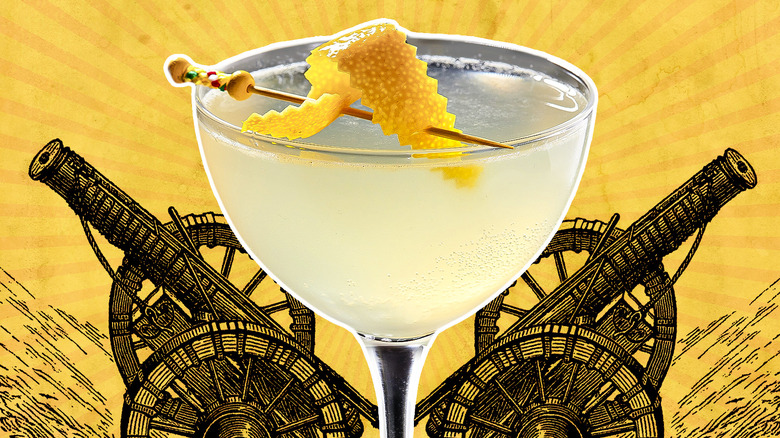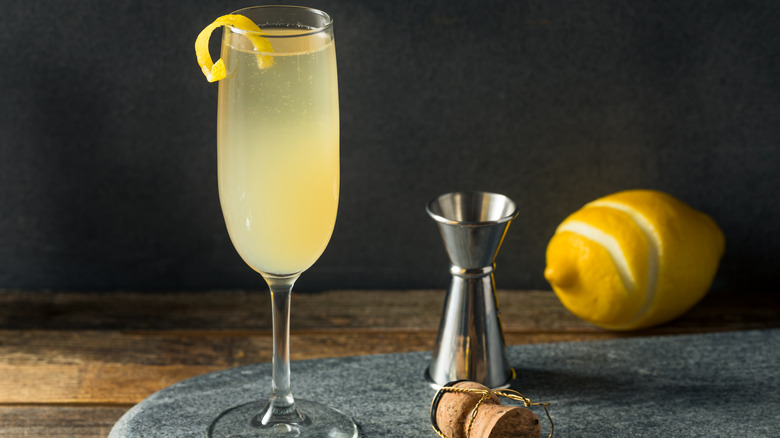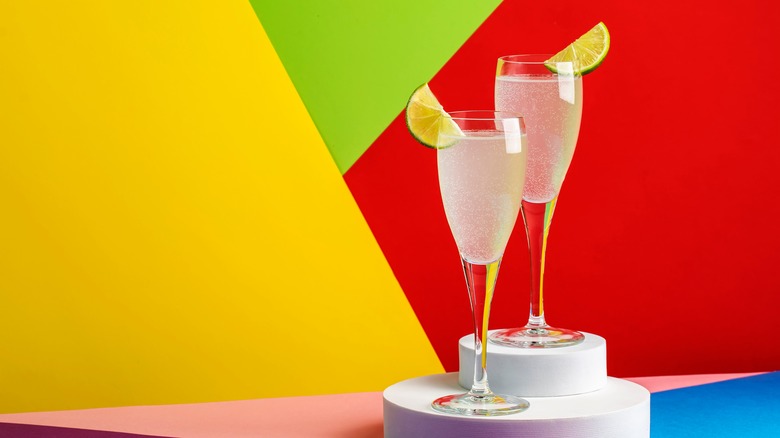How The French 75 Cocktail Got Its Name From WWI
Cocktails pack in lots of intrigue. In addition to blending spirits in intricate ways, they reflect drinking trends and imprint historical stories. Some even intertwine with prominent snapshots in time: how FDR championed the Dirty Martini, for instance. In a similar vein is the French 75, which got its name from World War I.
The drink dates back to that tumultuous part of the 20th century, first mixed up by a bartender in Paris. Many credit bar owner Henry Tépé with crafting the inaugural batch, although as with many stories in mixology, the precise source is uncertain. What's clear is that by 1915, the drink appeared in print — specifically The Washington Herald — with the name Soixante Quinze, translating to 75 in French. The number is a reference to the highly effective French 75 mm field gun employed during the ongoing war.
Such a naming was more than just a jest at the drink's potency. Developed secretly during the late 19th century, the cannon revolutionized the nature of artillery. The weapon provided France a newfound advantage in World War I, by way of its quick-firing nature, portability, and lethality. It became established as a symbolic source of pride, reflected in much of the cultural output of the time. Although close to the active frontlines, Paris bars were in full swing at the time, mixing up strong slings with whatever spirits were available. The cocktail name emerged as a token of national pride in precisely such a drinking context.
The French 75 has evolved through many forms
Today's French 75 does pack quite a punch, building a shot of gin, lemon juice and simple syrup, then topping the mixture with a dry champagne. Served in a flute, it's a drink that offers a delicate balance of dry and sour notes, all in a classy — yet dangerously sippable — form.
Additionally, it can also be one of the best cognac cocktails, with a simple shift of base spirit. Such a liquor imbues it with a heavier character, slightly spiced characters. And there are few other riffs that play on the name, too — like the French 95 which employs bourbon, or the Mexican 55 with tequila. What's constant in its modern interpretation is the dry champagne topping, which adds effervescence and amps up the potency. However, the original version actually didn't include the bubbly at all.
Instead, the first noted recipe in Paris meshed together equal parts of gin, grenadine, and applejack, all finished with some lemon juice. In the decade after its invention, it morphed through several formats, adding in ingredients like calvados and absinthe, before arriving at today's go-to ingredients in 1927, although served over ice. The drink kept shifting, and came to today's flute format in the 1980s — a showcase of just how many riffs can be attributed to a single name.
The gin and champagne pairing dates back to the 19th century
The French 75 first integrated gin and champagne in 1927, published in a compendium by Judge Jr. This riff on the drink came in the large, round Collins glass filled with ice; some suggested the vessel was selected to evoke an artillery shell. Although the first time the drink's modern components were mixed with a record ratio, it wasn't the first spirituous pairing of champagne and gin.
Such a duo already enjoyed popularity in the 19th century, with numerous appearances in print. None other than Charles Dickens was known to enjoy a drink made with champagne, gin and lemon in 1867 — quite similar to what became the French 75. And the combo of gin and sparkling wine was beloved by Queen Victoria's son. It was a pairing so prominent that it carried the nickname "King's Peg" around the British Empire.
In fact, serving champagne in a mixed drink came along only a few decades after the origin of the word "cocktail." A recipe was included in Jerry Thomas's influential "How to Mix Drinks, or The Bon Vivant's Companion," released in 1862. So, by the time the French name was lended to this potent combination, it was hardly an innovation, but already a long established drinking habit.


